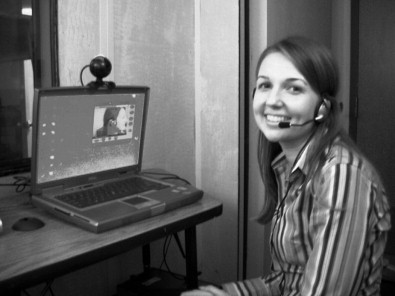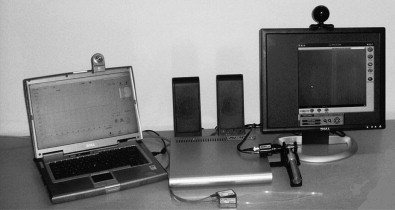Teleaudiology has become a more viable approach to delivering care. Asynchronous and synchronous delivery can be used to deliver Teleaudiology. Hybrid delivery involves using both synchronous and asynchronous modes of delivery. Teleaudiology has been used for otoscopy, audiometry, immitance, cochlear implant programming and newborn screening. Teleaudiology is a viable technology, although reimbursement remains unclear.
While telehealth technology has been used for over a century, teleaudiology research began in the mid-1990s. Teleaudiology research in this era incorporated video otoscopy, hearing aid fittings using remote computing technology, and synchronous applications with hearing testing. Over the past 10 years, teleaudiology research has been limited until recently, when several publications describing different systems dedicated to hearing assessment and rehabilitation were published. The catalyst behind the growth of teleaudiology was due to the advent of low-cost (but effective) Web cameras and affordable broad-band connectivity. At the same time, audiology equipment for diagnosis, hearing aid fittings, and for cochlear implants became increasingly computerized. Consequently, clinicians were able to interface computerized audiology equipment with telehealth technology to provide a variety of hearing health care services to underserved communities. Teleaudiology is still in its early stages, and considerable research is necessary before widespread audiology services can be confidently offered using telehealth technology.
Asynchronous data transfer is most commonly used today by hearing health care professionals. Specifically, asynchronous technology is used when information such as tympanograms, audiograms, auditory brainstem response recordings, or video-otoscopy images are transmitted via E-mail or by fax. Asynchronous studies have been published evaluating the efficacy of telehealth with tympanometry, video-nystagmography (VNG), and video-otoscopy. In addition, E-mail communication has been used to deliver cognitive–behavioral therapy for tinnitus treatment and for counseling new hearing aid users.
One appealing asynchronous application is self-assessment of hearing sensitivity. Presently, self-assessment procedures involving hearing testing online appear to suffer from questionable calibration, poor validation, and the lack of control over environmental noise levels. However, phone-based hearing screening programs using speech in noise stimuli as described by Smits and colleagues have been validated and overcome many of the calibration issues associated with pure tone testing over the phone.
Synchronous services are characterized by the clinician delivering services to clients in real time or live. Interactive video is typically used with synchronous services to observe patient responses to stimuli and to assure clinicians that audiometric equipment (transducer, probes, and electrodes) are properly placed. Interactive video may be provided by a laptop Web camera or by a dedicated camera system that is interfaced directly to the computer network. While interactive video can require substantial bandwidth, the benefits are obvious, providing the clinician and patient with services that are essentially face to face.
Audiologists may use 2 models of synchronous telehealth models. The first model is the traditional telehealth model in which only interactive video is used to implement services. This model requires the extensive use of high-quality interactive video for the clinician to supervise technician test procedures at the remote site. Once the technician obtains patient data, the clinician will typically provide a diagnosis and recommend management.
Synchronous teleaudiology has already been used successfully by Marincovich in the mid-1990s to provide hearing evaluations and hearing aid fittings in a rural region of California (Peter Marincovich, PhD, April 2009). In implementing this model, the technician must be trained well enough to administer, but not necessarily interpret, audiology test results. Rather, interpretation and counseling are done by the hearing health care professional using interactive video with the patient. This is an effective solution when the technician turnover is low, and ongoing technician training is possible. Also, the traditional model has the benefit of comparatively modest technology requirements.
Another form of synchronous audiology services incorporates remote control, in so that clinicians can test patients at distant sites. This is a reasonable telehealth strategy to consider, as many audiology systems are computerized and use a Windows operating system. Therefore, a clinician at 1 site can control computerized audiology equipment at a distant site using application sharing (or remote computing) software through a network, modem, or the Internet. In essence, remote computing creates a method that extends the hands of the clinician from 1 clinic site to another ( Fig. 1 ). The greatest advantage to this method is that a technician is not required to do testing at the patient site. Therefore, technician skills and training are not critical. However, a technician is still required to do tasks such as providing patient basic instructions, transducer placement, and otoscopy. Additionally, he or she must have some skills in running the computer at the patient site. Figs. 2 and 3 provide an example of equipment that can be used at the evaluator and patient locations.



Using this paradigm, investigators have employed synchronous protocols to administer a variety of common hearing tests to subjects including pure tone, speech, otoacoustic emissions, and the auditory brainstem-evoked response. In addition, synchronous technology has been used to program hearing aids and cochlear implants. The model for delivery is illustrated in Fig. 4 . Remote computing technology presently requires further validation but has been used successfully to administer hearing tests over considerable distances. The fiscal limitation of these applications is due to the need for personnel participating in the care at both locations. Currently, reimbursement for audiologic services is difficult with 1 provider involved in the care. The addition of personnel at the remote site makes the financial viability less favorable. Further clinical and financial validation is needed to increase the adoption of teleaudiology.

Hybrid model
While the sole use of asynchronous or synchronous technology appears to be reasonable in some circumstances, clinicians should consider the most efficient system to deliver telehealth services. In many cases, a combination of synchronous and asynchronous technology will yield the best solution for hearing health care services. This combination of technology is considered a hybrid model and is regularly used in successful telehealth programs. A recent study was published describing hybrid hearing screening services for young school-aged children. The investigators of this study used interactive video via a Web camera to see the responses of children receiving hearing screenings. In addition, the investigators used remote computing to present pure tone stimuli at the school, an audiometer that was purposefully developed for telehealth applications and video-otoscopy interfaced to the Web camera. Tympanometry results were viewed via Web camera at the time of the screening, scanned into a computer at the end of the day, and then later sent via email to the investigators for final interpretation. One of the issues with research in teleaudiology is few authors are describing a complete battery of diagnostic hearing services. In all likelihood, hybrid systems will be used in the future to offer complete hearing services.
Emerging teleaudiology
Telehealth and Infant Applications
In all likelihood, telehealth will be increasingly used by practitioners involved with early hearing detection and intervention (EDHI) programs. In recent funding programs, the US government has encouraged statewide EDHI programs to use teleaudiology applications. This is not surprising, as EDHI program goals can be difficult to achieve due to inadequate professional expertise, lack of program planning, and insufficient funding. Further, an EDHI program should exhibit continuity of services, up-to-date information, operate as a community-based health program, and provide accurate tracking information for newborns requiring further screening or assessment. O’Neil and colleagues, addressing similar EDHI issues, suggested new paradigms should be developed to ensure that each infant is provided needed services regardless of circumstances. Such a paradigm may incorporate telehealth services. However, telehealth has not been widely used to provide hearing screening or assessment services to infants.
Remote Computing Infant Hearing Assessment
Screening and diagnostic services are ordinarily administered using otoacoustic emissions (OAEs) or the auditory brainstem response (ABR). One intriguing aspect of ABR and OAEs systems is they are usually computer peripherals operated through desktop personal computers (PCs). Consequently, many ABR and OAE systems can be employed for both synchronous and asynchronous telehealth applications.
Synchronous computing applications for infant hearing screening seem to have at least 3 advantages. Specifically, when hearing screenings procedures cannot be accomplished face to face, a hearing heath care professional could conduct hearing screening from another location. Also, once personnel are trained to conduct infant hearing assessment in underserved area, these individuals can be mentored and supervised by a hearing health care professional in real time while screening clients. Another advantage to remote computing is that it can be used to observe practices at distant centers for quality control purposes. Such an application might be considered to achieve appropriate referral rates and to reduce excessive false positives.
Only 2 papers have been published concerning telehealth and OAEs and ABR in pediatric populations. One publication discussed theoretical pediatric applications of telehealth and otoacoustic emissions written by Krumm and colleagues. This paper provided rationale, models, and pilot data supporting the use of telehealth technology with infant hearing screening programs.
In 2008, Krumm and colleagues described a study in which they used remote computing technology to record distortion product otoacoustic emissions (DPOAEs) and automated auditory brainstem audiometry response (AABR) data with infants. Specifically, 30 infants ranging in age from 11 to 45 days (with an average age of 16 days) were seen for this study. Subjects recruited for this study did not pass prior DPOAE screening at birth and were being seen for rescreening at their regional medical hospital. Results obtained via face to face and via telehealth were essentially equal according to the authors. While most of the infants in this study were normal, the results suggest that synchronous (or a hybrid system) would provide reasonable support for EHDI programs lacking personnel expertise in underserved areas. Fig. 5 is a screen capture of a synchronous session in which the child was receiving hearing evaluation with a DPOAE system.





